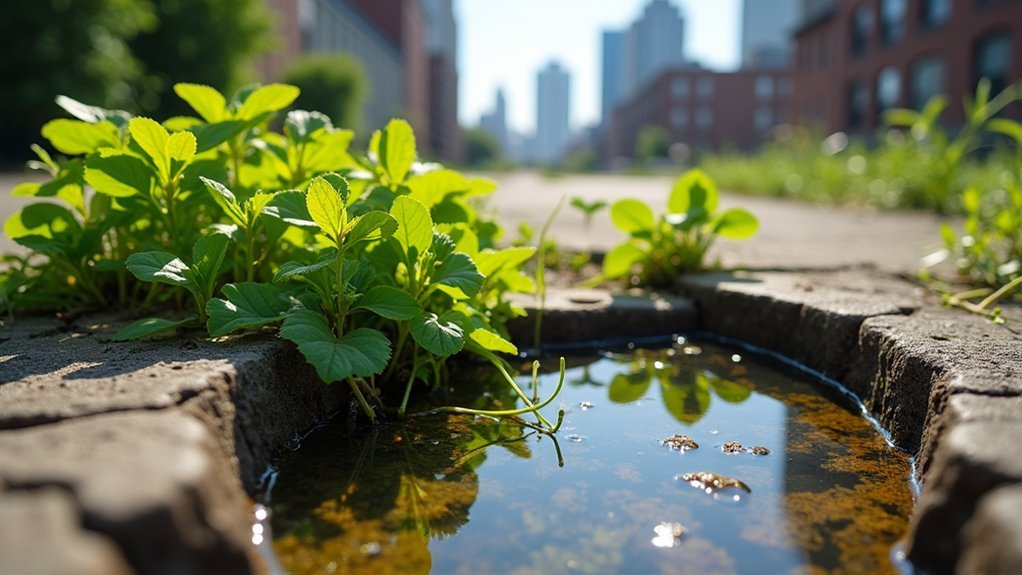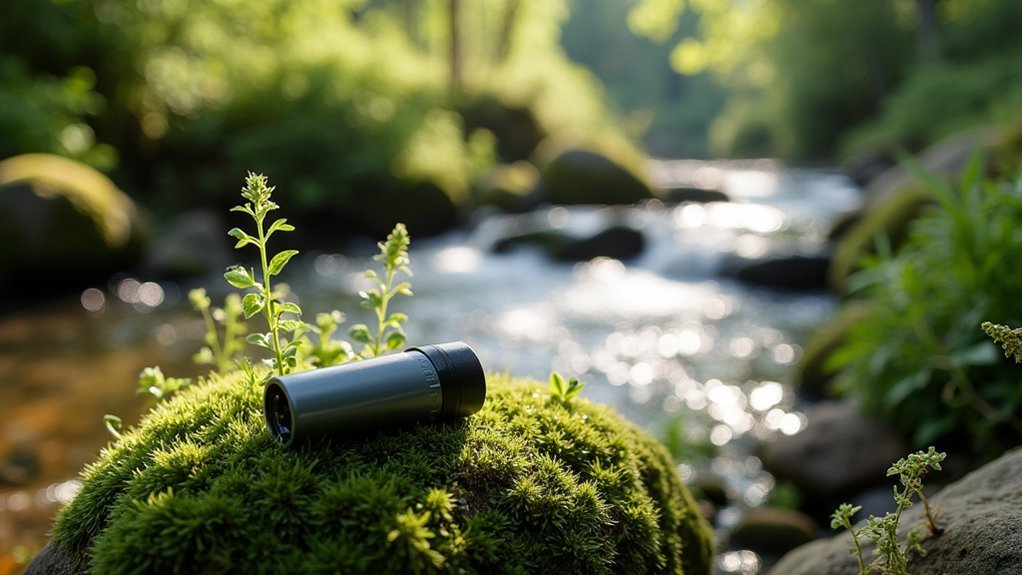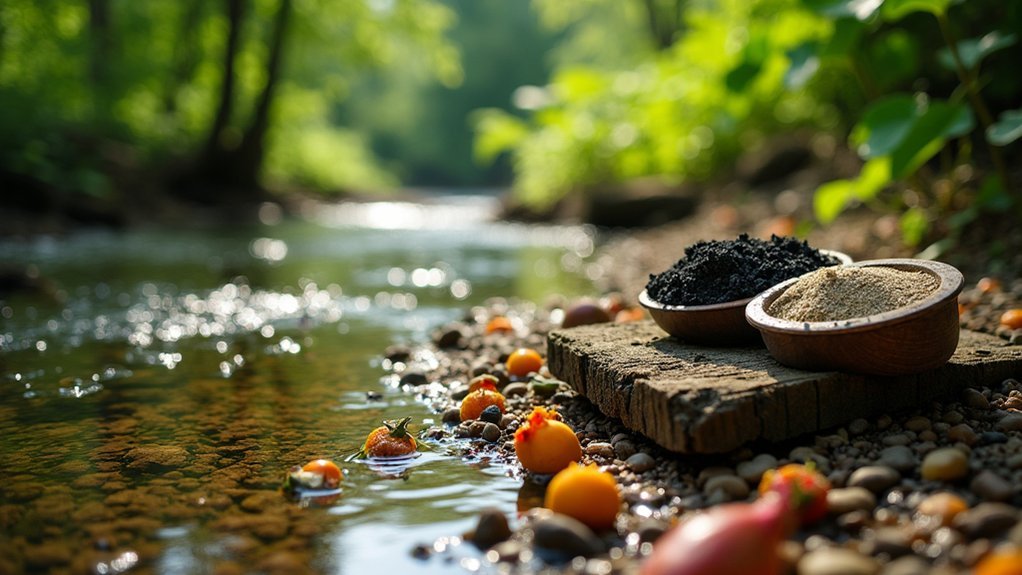Urban foragers must clean their water supply because contaminated urban water can introduce heavy metals, pesticides, and pathogens into foraged foods. You'll risk serious health issues like gastrointestinal illness, neurological damage, and long-term toxicity if you use polluted water to rinse or process wild edibles. Even seemingly clean water sources may harbor invisible contaminants that bioaccumulate in plants. With proper testing and filtration methods, you can protect yourself while enjoying sustainable urban harvests.
Why Urban Foragers Must Clean Their Water Supply

While urban foraging has gained popularity as a sustainable food practice, ensuring clean water sources remains a critical yet often overlooked aspect of the process.
When you forage in contaminated areas, you're not just collecting edible plants—you're potentially gathering harmful substances that have accumulated from urban runoff and sewage overflow.
Your water supply may contain heavy metals, chemicals, and dangerous pathogens like Giardia that can make you seriously ill if ingested. These contaminants affect both your health and the quality of your foraged foods. They can also reduce crop yields and create food safety risks.
Regular cleaning and monitoring of your water is essential for urban foraging success.
Remember that even pollinators prefer polluted water sources, creating a chain of contamination that affects the entire ecosystem.
Common Contaminants in Urban Water Sources
You'll encounter heavy metals like lead and arsenic in urban waterways, which accumulate quickly in your foraged resources due to industrial runoff and aging infrastructure.
Pesticide and herbicide contamination poses serious dangers, especially after rainfall when these chemicals wash from residential landscaping and nearby agricultural areas.
E. coli and Giardia thrive in specific urban water locations, particularly where sewage overflow occurs or in stagnant water bodies with limited circulation.
Heavy Metals Accumulate Rapidly
Despite their natural presence in the environment, heavy metals like lead, arsenic, and cadmium pose serious threats to urban foragers due to their rapid accumulation in water sources.
In urban areas, industrial runoff and aging infrastructure accelerate heavy metal contamination in local waterways, making your water source potentially hazardous even when it appears clean.
When you're foraging on private property or near contaminated soil, be aware that stormwater runoff carries these toxins directly into ponds, streams, and lakes where aquatic plants grow.
What's particularly concerning is that these metals can't be eliminated through cooking. Even low concentrations can harm you, with children and pregnant women at greatest risk.
The roots of edible aquatic plants readily absorb these contaminants, making thorough cleaning essential before consumption.
Regular testing of your harvesting sites is vital for your safety.
Pesticide Runoff Dangers
Urban water sources face another invisible threat beyond heavy metals: pesticide runoff. When you collect water from roadside ditches and drainage areas, you're likely gathering harmful chemicals like glyphosate and atrazine that wash away from nearby lawns, gardens, and agricultural areas.
These pesticides exceed safe thresholds in many urban waterways, creating serious health risks when you use contaminated water for harvesting edible plants. The chemicals can cause endocrine disruption and increase cancer risk through regular exposure.
As a forager, you must prioritize water safety by thoroughly cleaning and filtering any urban water source before use.
Remember that pesticide concentrations spike during rain events when chemicals wash from treated surfaces into collection areas, making water quality assessment an essential step in your urban foraging practice.
Microbial Pathogen Hotspots
While chemical pollutants threaten water quality, invisible microbial pathogens present an equally dangerous risk in urban water sources. When you forage in urban areas, you'll encounter water bodies potentially contaminated with E. coli and Giardia—organisms that can cause severe illness if consumed without proper treatment.
During rainstorms, sewage overflows introduce harmful bacteria into urban waterways, making any aquatic plants you gather potentially unsafe. Standing water in puddles and bird baths quickly becomes breeding grounds for dangerous microorganisms.
Safety when harvesting near water requires understanding that these sources may contain not just microbial pathogens but also heavy metals and agricultural runoff.
Regular monitoring and testing of urban water sources before using them for foraging activities isn't optional—it's essential for preventing waterborne illness and ensuring what you collect is safe to consume.
Health Risks of Using Polluted Water for Foraging
When you use polluted water for foraging, you're risking exposure to pathogens like Giardia and heavy metals that can accumulate in your body, potentially causing long-term neurological damage.
You'll need to test your water sources using commercial kits that detect common contaminants such as pesticides, industrial chemicals, and biological hazards before using them for rinsing or cooking.
To protect yourself, always boil collected water for at least one minute, use activated carbon filters to remove chemicals, or invest in portable water purification systems specifically designed for outdoor use.
Contaminants Health Impacts
Foraging from water sources contaminated with pollutants poses significant health risks that urban foragers can't afford to ignore. When you collect plants from polluted areas, you're exposing yourself to dangerous toxins that can accumulate in foraged foods.
- Pathogen exposure: Contaminated water sources may contain Giardia and other pathogens that cause severe gastrointestinal illness, though cooking can eliminate some risks.
- Heavy metal accumulation: Lead and arsenic from polluted water can build up in plants, potentially causing neurological damage and developmental issues over time.
- Chemical toxicity: Urban runoff introduces pesticides and chemicals that bioaccumulate, especially in root systems of aquatic plants, leading to hormonal disruption and increased cancer risk.
Always assess water quality before foraging, avoiding sources with visible pollution or strange odors to protect your long-term health.
Water Testing Methods
Testing water sources adequately before foraging represents a critical safety step that many urban foragers overlook. You should collect samples for laboratory analysis to check for dangerous contaminants like E. coli, Giardia, heavy metals, and chemical pollutants that can cause severe gastrointestinal illnesses and long-term health issues.
Home test kits are available to detect bacteria, pH levels, and specific contaminants in your water sources. While boiling water for at least one minute kills pathogens like Giardia, it won't remove chemical contaminants—highlighting why testing must precede purification.
Stay informed by regularly monitoring local water quality reports from environmental agencies. These provide valuable information about pollution levels in specific areas, helping you make safer decisions about where to harvest.
Proper testing methods guarantee you're not exposing yourself to invisible dangers while foraging.
Purification Best Practices
Because urban water sources often harbor invisible threats, proper purification becomes essential for safe foraging practices. When you rinse or cook foraged plants with contaminated water, you're transferring pollutants directly to your food—negating all your careful harvesting efforts.
To minimize health risks while urban foraging, implement these purification methods:
- Boil collected water for at least one minute to eliminate pathogens like Giardia that cooking alone might miss.
- Use portable water filtration systems designed to remove heavy metals and chemical pollutants.
- Carry clean water from home specifically for rinsing your foraged items.
Remember that water cleanliness affects every aspect of foraging. Even if you thoroughly cook aquatic plants, using polluted water during preparation can reintroduce harmful substances like pesticides and sewage runoff to your otherwise safe harvest.
Assessing Water Source Safety During Urban Harvests
When you're gathering wild edibles throughout urban environments, evaluating nearby water sources becomes just as critical as identifying the plants themselves.
Urban water can harbor heavy metals from industrial runoff, sewage overflow, and agricultural chemicals that compromise your foraging safety.
Assess water quality by examining clarity, looking for algae blooms, and noting any unusual odors that signal contamination.
Before using water to rinse or process your urban foraging finds, consider boiling it to eliminate pathogens like Giardia.
Avoid harvesting aquatic plants—especially roots and rhizomes—from visibly polluted waters, as these plant parts readily absorb environmental contaminants.
Stay informed about local pollution sources and regularly check public health advisories for your foraging areas.
Your awareness of water source safety directly impacts the wholesomeness of your wild-harvested foods.
Portable Filtration Methods for Foragers on the Go

Urban foragers who venture beyond their neighborhoods need reliable water purification solutions to support their harvesting adventures. Compact portable filtration methods like Sawyer Mini and LifeStraw effectively eliminate harmful pathogens such as Giardia and E. coli, ensuring you have pure drinking water on your foraging trips.
Your filter systems' effectiveness depends heavily on water quality, so consider:
- Pre-filtering murky water through cloth to extend your filter's lifespan
- Using UV light purifiers like SteriPEN to treat a liter in just 90 seconds
- Maintaining and cleaning your devices regularly, especially after filtering heavily contaminated water
These precautions allow urban foragers to safely hydrate while harvesting wild foods, regardless of how far you roam from conventional water sources.
Natural vs. Chemical Water Purification Techniques
While exploring urban environments for forageable resources, you'll often face the critical decision between natural and chemical water purification methods.
Natural water purification techniques like sand, charcoal, and gravel filters can effectively remove particles without adding taste, while activated carbon filters eliminate chlorine, sediment, and harmful organic compounds.
Natural filtration methods preserve water's original taste while effectively removing contaminants that threaten your urban foraging hydration needs.
Chemical purification methods using chlorine or iodine tablets kill bacteria and viruses but often leave an unpleasant taste. They're quick solutions when you need safe water immediately, though not ideal for long-term use.
Boiling remains the most reliable natural method, requiring just one minute of rolling boil to eliminate most pathogens.
For chemical-free alternatives, consider UV light purification, which effectively inactivates microorganisms without altering water taste or requiring additional filtration steps.
Ensuring Clean Water for Processing Foraged Foods

Before you consume any foraged foods, you'll need clean water to properly process them. Without thorough washing, your wild harvests might harbor soil, dust, or harmful pathogens that can make you sick.
Always rinse items in cold water to effectively reduce surface contaminants.
When processing foraged foods, be mindful of your water source:
- Avoid untreated water that may contain microorganisms like Giardia
- Never use chlorinated pool water, which introduces unwanted chemicals
- Select water from uncontaminated streams or municipal supplies instead of polluted sources
Remember that water quality directly impacts your foraged food's safety.
Filtering or treating your water supply guarantees you're not introducing additional hazards when attempting to clean your wild edibles.
Season-Specific Water Quality Challenges
As the seasons change, so do the water quality challenges facing urban foragers.
In spring, melting snow increases runoff, concentrating pollutants and contaminants in water sources you might use for processing foraged items.
Summer brings warmer temperatures that promote toxic algal blooms in stagnant water, requiring additional filtering steps.
Fall introduces unique season-specific problems as decaying leaves and plant matter contaminate water with pathogens and increase turbidity. You'll need to clean harvested water carefully during this time.
Winter forces greater reliance on artificial water sources like bird baths, which often harbor bacteria and chemicals.
Throughout the year, shifting runoff patterns alter heavy metal concentrations in urban water supplies.
You should test and purify any water you collect during foraging activities, adapting your cleaning methods to each season's particular water quality challenges.
Frequently Asked Questions
Is It Safe to Forage in the City?
Foraging in cities can be safe if you're cautious. You'll need to avoid polluted areas, know local contamination sources, and properly clean your finds. Always research your location's history before harvesting anything.
How Does Foraging Help the Environment?
When you forage, you're promoting biodiversity, reducing food waste, and fostering environmental stewardship. You'll develop deeper connections with nature, help preserve green spaces, and encourage community engagement in protecting local ecosystems.
Where Is It Legal to Forage?
You can legally forage on public lands with permissions, private property with owner consent, and some federal lands. Always check local regulations, as rules vary widely between parks, municipalities, and protected areas.
How to Start Urban Foraging?
To start urban foraging, identify local edible plants using field guides, join community workshops, document your findings in a journal, and always verify you're harvesting legally. Don't forget to thoroughly clean everything you collect.
In Summary
As you build your urban foraging practice, you'll find that clean water is your most essential tool. Don't underestimate the invisible threats lurking in urban water sources. By consistently using proper filtration methods and staying informed about local water quality, you're not just protecting yourself—you're honoring the traditional knowledge that connects sustainable foraging to safe water stewardship. Your health depends on this vital final step.




Leave a Reply